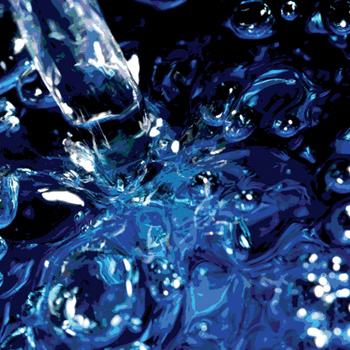A new technology has taken the housekeeping industry literally by storm this past year. It is activated water. The recent threat of an H1N1 pandemic severely impacting our public health prompted new and innovative ways for spot cleaning, particularly to clean frequently touched surfaces (frequently referred to as “high-touch” or “common-touch”) in institutions in which the flu finds an ideal fomital transmission environment, such as schools, hospitality, recreational and correctional facilities.
Because several states, as well as the U.S. Federal Government, are aggressively urging the housekeeping industry to embrace the concept of sustainability and green cleaning, coupled with the U.S. Environmental Protection Agency (EPA)’s Tools for Schools initiative, the housekeeping professionals have responded by seeking better ways of cleaning with products of lower toxicity and zero persistence in the environment. Not surprisingly, nothing meets this criterion better than water.
As sanitarians in the public health arena, we are not only concerned with cleaning but also with significantly reducing the bioburden as we clean. Additionally, by way of disease prevention, maintaining the potential bioloads of these surfaces as low as possible, under practical and cost-effective conditions, makes the use of water, in any form, ideal.
Disinfectant versus Sanitizer
However, before I go on to explain the phenomenon of activated water products and their potential use in the retail food industry, let me first take this opportunity to clarify the terminology we use in its description and to place activated water in the proper context of cleaning and bioload reduction.
Activated water closely fits the criteria of cleaner and “sanitizer” versus that of a “disinfectant.” To make this distinction, I found an excellent short lexicographic essay written by someone at Hillyard Chemical. I am taking the liberty of paraphrasing this piece for brevity of explanation.
The difference between a “disinfectant” and a “sanitizer” is one of application. Whereas the health care industry is mainly interested in “disinfectant” data, the foodservice-related industries guided by the Public Health Services are primarily concerned with “sanitizer” claims. The actual difference between the two terms is, to some extent, a matter of legal definition. In current American regulatory parlance, a disinfectant is a product that completely destroys all specific test organisms in 10 minutes under conditions of the AOAC Use Dilution Test, whereas a sanitizer is a product which destroys 99.999% (or a 5-log reduction) of specified test bacteria in 30 seconds under conditions of the Official Detergent Sanitizer Test. Obviously, both deal with different aspects of the same problem: killing bacteria.
Interest in the use of germicides used in hospitals centered on completely destroying all possible microorganisms. In the normal course of hospital application, it was felt practical to allow at least 10 minutes of contact time to accomplish this objective. As a result, most disinfectant tests were developed to ascertain whether any bacteria survived 10 minutes of germicide contact—nothing more, nothing less. In fact, when contact times significantly less than 10 minutes are allowed, it becomes very difficult to get any kind of meaningful results out of the Use Dilution Test.
In foodservice and other public health-related industries, interest in germicides took a different approach. It became obvious that the conditions of use differed from hospitals and that tests based on 10 minutes of contact time could not be satisfactorily interpreted. Public health professionals reasoned that 30 seconds was about all the contact time they could realistically expect. Nevertheless, the prevailing disinfectant tests could not yield 30-second results. Therefore, they developed their own test—the Official Detergent Sanitizer Test.
Because the public health scientists did not anticipate that they could actually get complete kill in 30 seconds with any practical chemical agent, they developed a test in which bacteria are actually counted. They found that a 99.999% reduction in 30 seconds with practical agents was quite acceptable for the intended application and adopted this standard. To distinguish these products from disinfectants, they called them sanitizers.
The 5-log reduction rule of sanitizing took on new meaning when applied to newer methods for getting surfaces biologically clean. Validation of surface cleanliness with particle counting and adenosine triphosphate (ATP) let us redefine “clean” in a completely different context: where the 5-log reduction in organisms could actually be obtained through the physical act of cleaning. This meant that on a smooth surface, we could accurately measure the initial bioburden in negative log numbers by increasing the area of the test in much the same dynamic as determining the more traditional D, Z and F values we use for temperature and mass differences. After cleaning, we can now easily determine 5-log reduction estimates by measuring total ATP levels. Since microbial removal is part of overall biological cleanliness, it can be assumed that we can achieve a state of ‘sanitization’ using the same criteria that we do for hot water rinses in warewashers. Thus, from the applied data found in refereed journals and contract laboratory analyses, activated water has found a niche in chemical-free cleaning, with results quite comparable to those of sanitizing agents. In short, when used judiciously and with validation, activated water can replace chemical sanitizers in many applications in the retail food industry.
How Activated Water Products Work
There is considerable confusion about how the current generations of activated water cleaning products work. First, they all start with plain, potable, tap water. The water must be conductive. While most conventional products clean and sanitize based on chemical reactions, the newer, solid-state-activated water sprayers and scrubbers work mainly on principles of physics and electrical engineering. Contrary to popular perception, the process is not solely or mainly based on typical electrolysis. The technology does however use electrolysis, causing almost imperceptible pH and other changes in water chemistry, but these barely measurable effects are not the “active ingredients” used to clean.
Applying a small amount of electricity to water breaks down the water’s molecules, lowering its natural surface tension and creating positively and negatively charged water ions. When applied to a surface in this electrolyzed form, water can spread to contact dirt, just as it does when mixed with chemicals. The charged ions in the water attach to the dirt and help lift it from the surface.
In addition, water electrolysis is actually applied to “create” charged, nano-sized gas bubbles in the water. These electrically charged bubbles attach themselves to dirt particles, causing the particles in turn to become charged and repel from surfaces, thus enabling soils to be suspended in water and wiped away. Soil removal performance tests were developed and conducted by the University of Massachusetts’ TURI Lab. Most testing was performed to a modified ASTM G122 Test Method, a modified version of the Green Seal GS37 standard, the CSPA DCC 17 - Greasy Soil Test Method or the CRI Carpet Spot Cleaning TM 110 standard. The results clearly show that activated water cleaning works effectively on most common soils, including those found in food production.
As a sanitizing agent, the main “ingredient” behind the germ-killing effect of modern activated water devices is electroporation. This is a scientific process that applies a low-level electrical field to bacteria or viruses. This electrical charge creates holes or “pores” in the membrane of the cell, which breaks down the walls of the bacterial cells and kills them. It is also believed that pathogenic viruses are affected in the same way. Only when the unit is activated in which the water acts as a conductor does electroporation occur. With the newer hand-held devices, this entails spraying the surface constantly for 6 seconds to sanitize it. EPA-compliant Good Laboratory Protocol tests show that it works and is an effective, broad-spectrum sanitizer. One of the benefits of the electroporation technology is that it does not require contact or dwell time for efficacy. Contact with the spray itself was shown to cause an immediate 3-log reduction without any additional help from flushing or mechanical soil removal. Furthermore, the electrically activated water is completely safe and returns to its natural state in about 30 to 45 seconds. Studies show that electrically activated water cleans as well as, or better than, traditional general-purpose cleaning chemicals.
Electrolyzed Water
There is yet another cleaning method that predates activated water but uses tap water and table salt. It is commonly dubbed electrolyzed water where ions are basically scrambled by an electric current. Unlike activated water, it relies on contact time for its efficacy as a cleaner and sanitizing agent. The generators use a combination of cell technology, salt and electricity to alter the molecular structure of water, creating a non-toxic, oxidized, antimicrobial solution that is capable of killing many pathogens in less than a minute. Opposed to smaller, hand-held devices with activated water, this is an in situ technology that has been used as an effective cleaner and broad-spectrum sanitizer for decades in Russia and Japan, and is finally winning acceptance here in the U.S. and Canada.
The sanitizing characteristics are a bit different in this technology. The high oxidation of the water first damages bacterial cell walls, allowing infiltration by water. The microbe reaches capacity, causing an osmotic, or hydration, overload. The acidic fluid and water floods the cell more rapidly than the cell can expel it, literally causing the cell to burst.
Although the initial cost for the water electrolysis unit is somewhat high, it can often be amortized in 1 year by replacing conventional cleaners in mop buckets, sprayers and anywhere harsher and more toxic cleaning chemicals are currently used or needed. In addition, it has no odor, nor does it produce foam, making it ideal for use in food production. There are numerous citations in the scientific and industry literature that this technology has effectively demonstrated excellent cleaning ability in the dairy, poultry and produce industries. Test results showed that for a dwell time between 7.5 to 10 minutes, electrolyzed water was as effective in removing organic matter as conventional treatments, making this technology ideal for general use in retail food establishments.
Conclusion
These technologies show great promise, limited only by our imagination. I predict that full approval and acceptance of both activated and electrolyzed water as cleaners and sanitizers in the retail food industry will soon become a reality.
On a personal note, activated water hand-held generators have been used in my home for general cleaning for over a year. I have used both ATP swabs and RODAC plates in various small experiments in which comparisons were made between activated water and brand-name household chemicals purchased from my local supermarket. I found virtually no difference between the two. Because the activated water generator is always available and requires a mere press of the trigger, it is used considerably more often than the conventional cleaners. Being a bit lazy, the idea that there is no additional bucket, dilution or mixing involved makes this technology particularly appealing. While it does not entirely replace all cleaning products, it has had a profound effect in reducing chemical use in my home (a good thing because I have a septic system) and has markedly improved overall cleanliness, particularly in the bathrooms.
If it works well for me, it certainly can work well in our industry. Going green has never been easier, and the more we know about these technologies, the greater the potential for overall food safety. As regulators, we need to embrace these technologies as soon as possible—regulations permitting.
Forensic sanitarian Robert W. Powitz, Ph.D., MPH, RS, CFSP, is principal consultant and technical director of Old Saybrook, CT-based R.W. Powitz & Associates. Feedback or suggestions for topics you would like to see covered can be sent to him directly at Powitz@sanitarian.com or through his Web site at www.sanitarian.com.
p>



